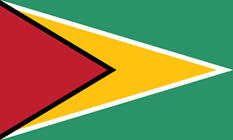
Esri provides a standard demographics dataset for Guyana sourced from data supplied by Michael Bauer Research GmbH. Visit Where to find ArcGIS Data to learn more about using standard demographics.
Release date
This dataset was updated in October 2024; the vintage is 2024.
Settlement points
Esri's Guyanese settlement points use the 2023 OpenStreetMap (OSM) Building Footprints. More information about the data can be found here: https:// www.openstreetmap.org. The data was verified using the latest Esri imagery.
Geography levels
| Esri geography name | Local geography name | Feature count |
|---|---|---|
Country | Guyana | 1 |
Regions | Regions | 10 |
Visualize demographic data variables
The data browser is an interface to help you visualize and explore the data categories and analysis variables available in this country or region's standard demographics. See Explore data variables to learn more about this visualization tool.
Standard demographics use cases
The Esri standard demographics dataset for Guyana is updated with Michael Bauer Research GmbH data updates to this region, approximately every two years. See the Related links section below for a complete list of variables, release notes, and a sample report.
Example use cases that may help you understand Guyana's standard demographics include the following:
Total Population
 | What is measured: The total number of individuals living in a specific area. How you use it: Population counts are often used by local and national governments for policy planning, resource allocation, and to make informed decisions based on the needs of different population groups within a country or region. You can use this data to explore the allocation of public services, economic development, political representation, social research, and resources available for disaster preparedness. |
Population Density
 | What is measured: The number of people per unit of area (sq. mile or sq. kilometer). How you use it: Population Density is typically used for national and local projects such as infrastructure design, urban planning to allocate and distribute public services, and to assess the environmental impact of human activity based on where people are concentrated. |
Population per Mill
 | What is measured: The number of individuals in a region per thousand. How you use it: Population per Mill is used to understand the comparative distribution of population around a country or region based on a per-thousand ratio. This data is used to support market trend analysis, infrastructure planning, and regional and national policy development. Population distribution is often used in health care to track disease prevalence or vaccination rates. |
Male/Female Population Totals
 | What is measured: The total number of males and females in a region's population. How you use it: Male and Female Population counts provide insight into gender balance, which is used for informed decision-making in areas like education, workforce planning, health care, and skills training. This data is also used to help interpret complex results, such as health-care outcomes, crime statistics, targeted marketing campaigns, and housing shortages. |
Population Totals by Age and Gender
 | What is measured: The distribution of regional population across age groups and gender. How you use it: Male and Female Population by Age counts can be used to help predict future social and economic trends and to plan for future resource allocation based on age groups in fields such as education, health care, and the labor force. This data is important for identifying potential challenges related to shifts in age or gender ratios within different age brackets. |
Total Households
 | What is measured: The total number of households in a region. How you use it: Total Household counts can help you understand the composition of a country's population based on how many people live in a single dwelling or housing unit. This data assists with informed decision-making in areas like government policy, business strategy, community planning, and social research. You can use household counts to identify community needs, allocate public policy funds, perform business market analysis, and design targeted social programs. Local authorities use household counts to plan for community development projects, considering factors like housing availability and density. |
Average Household Size
 | What is measured: The median or average size of households (people who share the same living quarters) in a region. How you use it: Average Household Size data helps you to understand the overall population structure and informs policy decisions related to housing, resource allocation, and service provisioning. This data is used to analyze economic trends, specifically consumption patterns, based on the number of people sharing living spaces in a region. |
Purchasing Power
 | What is measured: The ability of individuals or households to buy goods and services in a region. Purchasing Power data consists of four metrics:
How you use it: Purchasing Power data can help improve understanding of the potential consumer market in a country or region, specifically to determine pricing strategies and market potential options. This data can be used to develop targeted product, business, and sales strategies when entering a new market or expanding within an existing one. |
Related links
Refer to the following content:
- Release notes (PDF)
- Variable list (CSV)
- Sample report (PDF)
- Demographic map layers